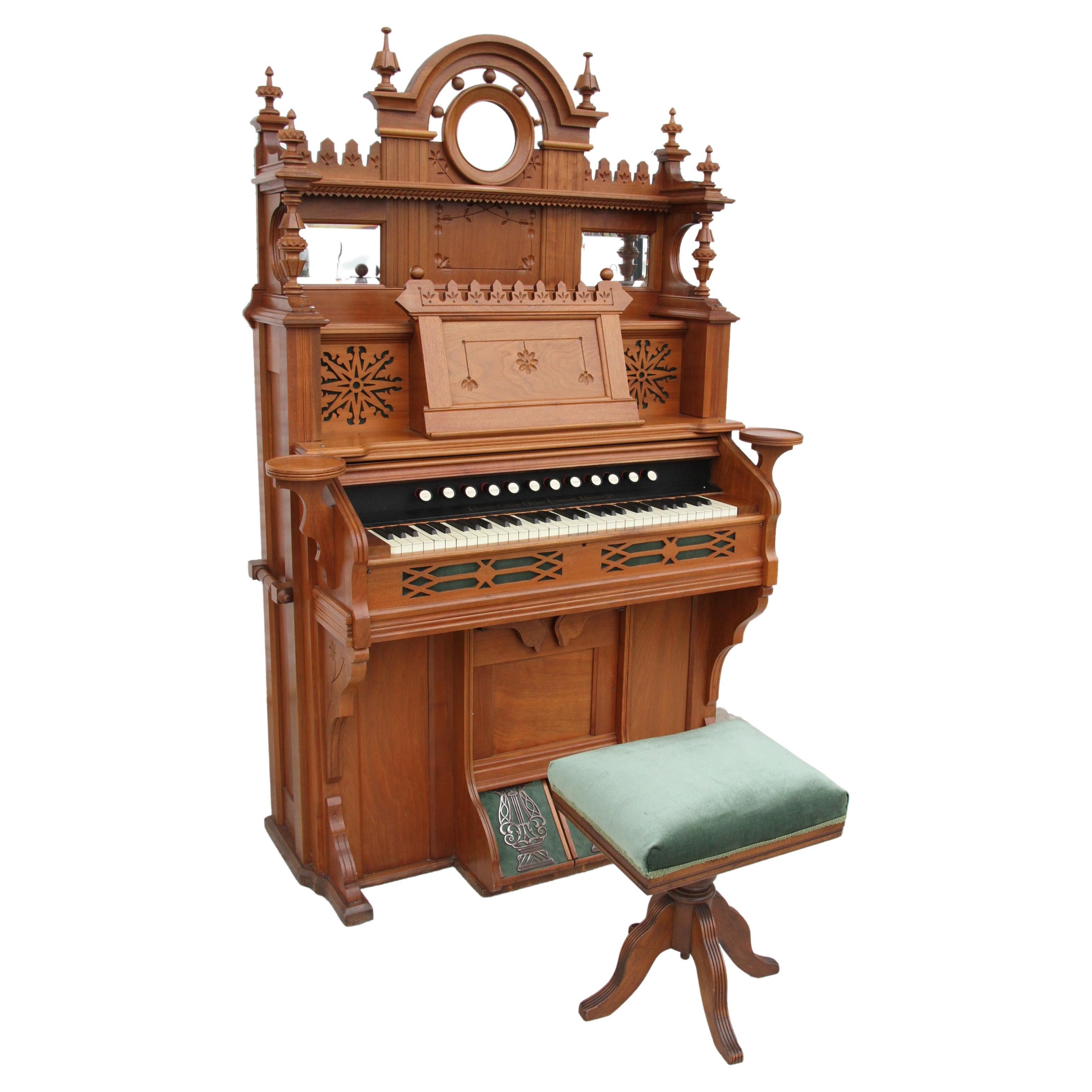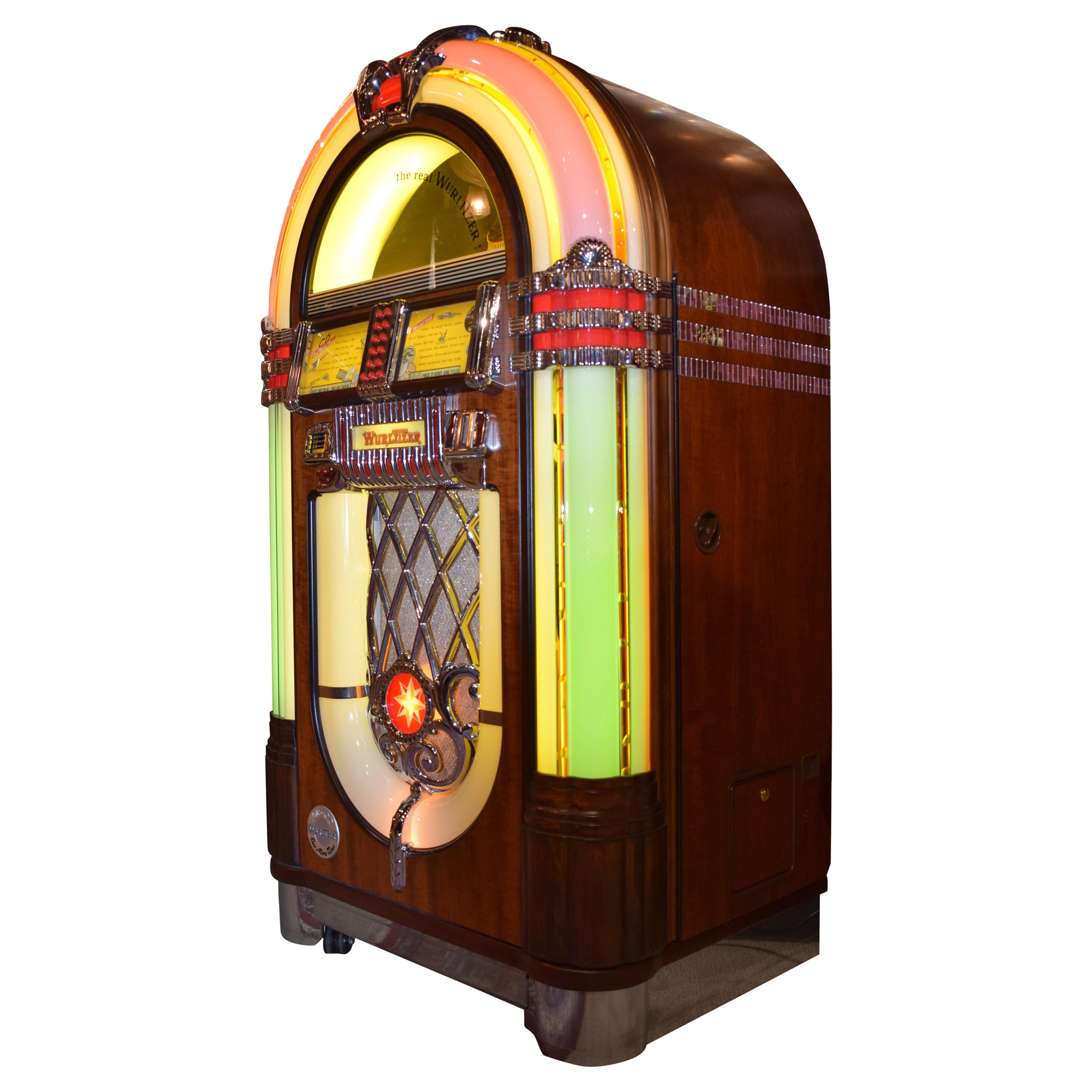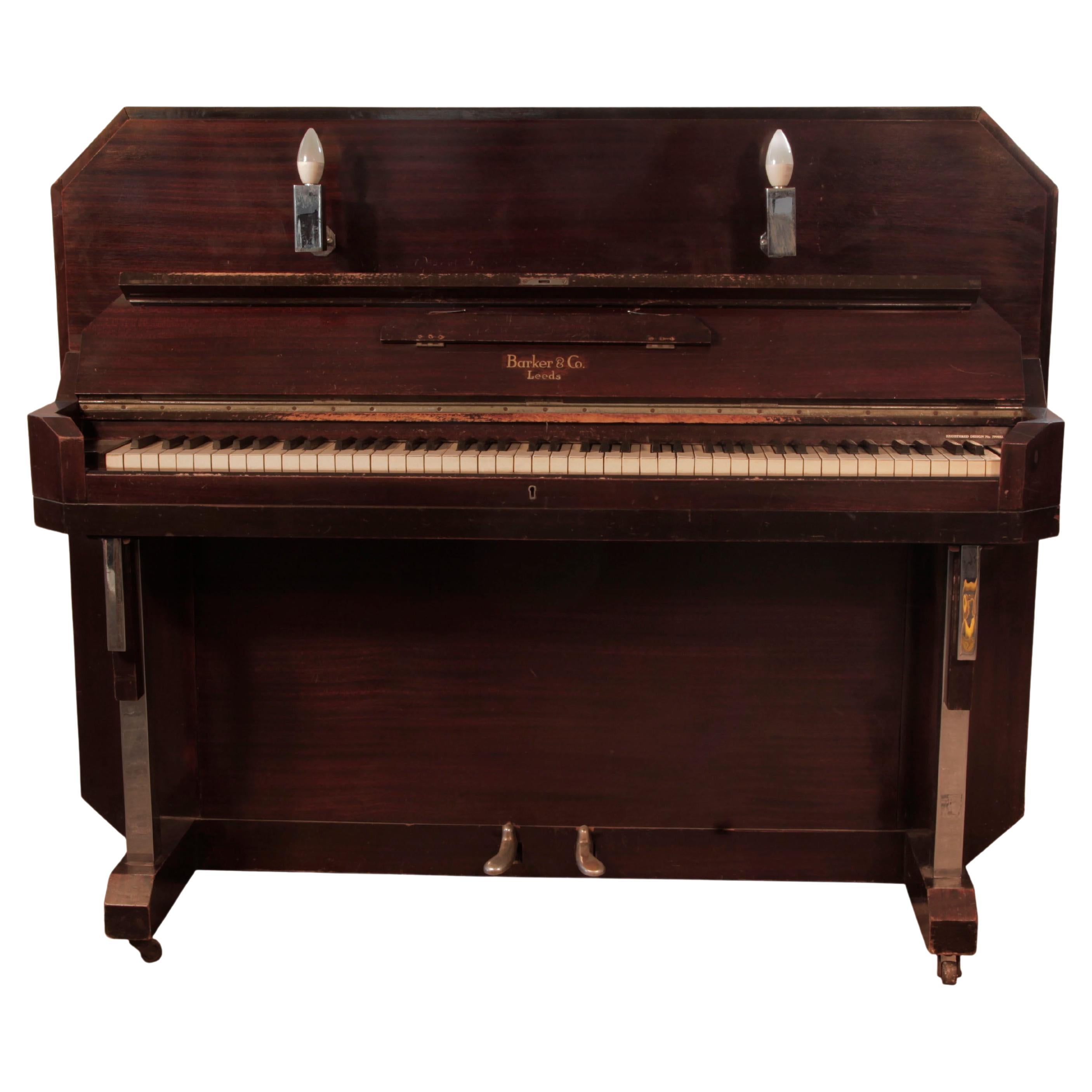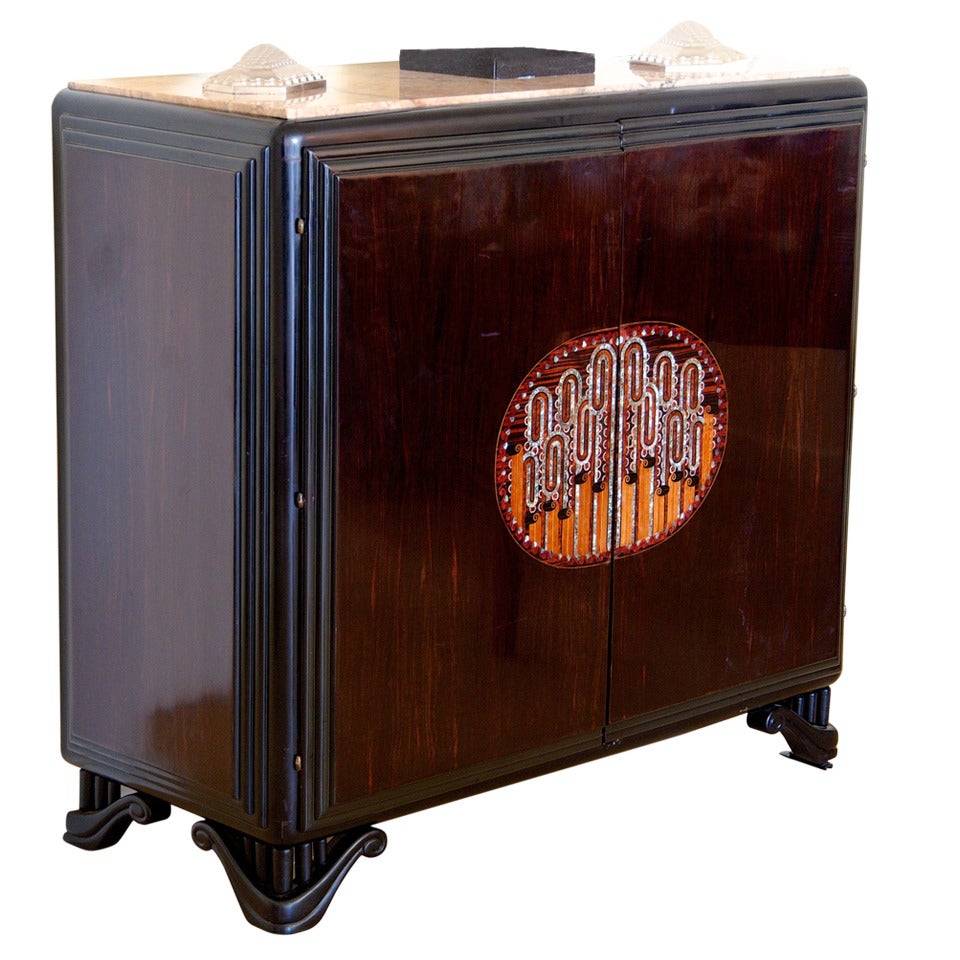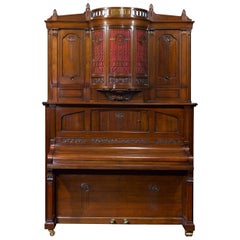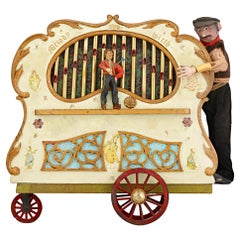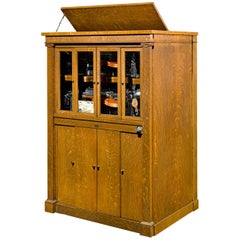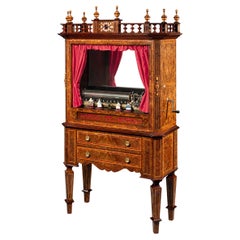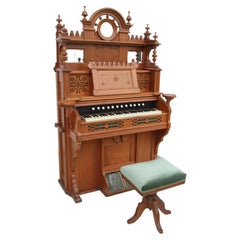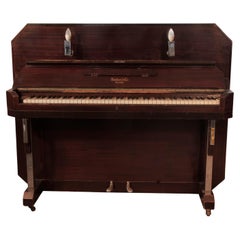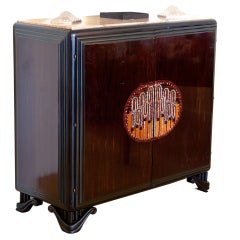Items Similar to Arburo Orchestrion Organ By Bursens And Roels
Want more images or videos?
Request additional images or videos from the seller
1 of 10
Arburo Orchestrion Organ By Bursens And Roels
$168,500
£127,922.33
€146,315.85
CA$235,418.93
A$261,837.24
CHF 136,723.27
MX$3,186,280.74
NOK 1,746,164.83
SEK 1,637,594.55
DKK 1,092,011.28
Shipping
Retrieving quote...The 1stDibs Promise:
Authenticity Guarantee,
Money-Back Guarantee,
24-Hour Cancellation
About the Item
Once a fixture in bustling dance halls, cafés and fairgrounds throughout Belgium and the Netherlands in early to mid-20th century, this incredibly rare, early Orchestrion organ is a masterpiece of automated music. Crafted by the Arburo firm run by Arthur Bursens and Gustav Roels, this mechanical marvel is essentially an entire band set within an elegantly constructed Art Deco cabinet. No two Orchestrions were ever created alike and each was made-to-order, one at a time. Each was crafted entirely by hand, even down to the paper music rolls, and utilized actual standalone musical instruments integrated into the mechanism.
The organ operates on electricity and its sound quality is breathtaking. Instruments including a visible accordion, 168-pipe organ, triangle and drums are all controlled by one of 20 rolls included with this Orcestrion. A powerful motor provides high air pressure to operate the pipes and the vacuum, which reads the roll and controls the percussion. This allows the organ to generate the volume necessary to overcome the noise of revelers in a crowded dance hall. Today, very few examples of these musical marvels exist, especially in the exceptional working condition of this example. Such splendid musical antiques generate tremendous attention on the market, making this organ a prized acquisition for musical enthusiasts world-wide.
Founder Joseph Bursens began his career working with his father at the Mortier organ manufactory in Antwerp. He began creating his own organs in his spare time, and eventually opened his own manufactory in Hoboken in 1908. Bursens quickly became known for his impeccably crafted dance hall organs, each a masterpiece of hand-craftsmanship inside and out. In 1928, Brusens' son, Arthur, took over the business and decided to take on a partner, Gustav Roels, renaming the company ARBURO (ARthur BURsens and ROels). Just like his father before him, Arthur learned the importance of quality, and continued to make each and every organ by hand. The reinvigorated company began creating their prized Orchestrions using the more functional paper roll instead of the accordion books of earlier models. This freed space within the mechanism for incorporating more musical instruments and mechanisms, while also allowing each Orchestrion to play more tunes without interruption.
The Orchestrion was created from the 1930s through the 1960s. However, this particular example dates to Bursens and Roels very first years of Arburo production. Arburo had moved their operations to the address Bernardsche Steenweg 635 in 1930: a larger locale that allowed them to meet their high demand. The trademark plaque affixed to the Orchestrion includes Bursens previous address "Bernardsche Steenweg, 181," meaning this Orchestrion was created between 1928 and 1929. Further confirming this date is the fact that the music roll is located at the center of the mechanism, while the rolls in later Arburo creations were positioned either to the left or the right.
This Arburo Orchestrion was showcased at the Arburo centennial exhibition Bursens Organs at Hoboken on October 4-19, 2008 at the Castle Sorghvliet of Hoboken, Belgium.
Circa 1928-29
105 1/2" wide x 50 1/4" deep x 102 1/2" high
- Creator:Arburo (Maker)
- Dimensions:Height: 102.5 in (260.35 cm)Width: 105.5 in (267.97 cm)Depth: 50.25 in (127.64 cm)
- Style:Art Deco (Of the Period)
- Materials and Techniques:
- Place of Origin:
- Period:
- Date of Manufacture:circa 1928-1929
- Condition:
- Seller Location:New Orleans, LA
- Reference Number:Seller: 29-90921stDibs: LU891136488032
About the Seller
5.0
Recognized Seller
These prestigious sellers are industry leaders and represent the highest echelon for item quality and design.
Established in 1912
1stDibs seller since 2010
109 sales on 1stDibs
Typical response time: 3 hours
- ShippingRetrieving quote...Shipping from: New Orleans, LA
- Return Policy
Authenticity Guarantee
In the unlikely event there’s an issue with an item’s authenticity, contact us within 1 year for a full refund. DetailsMoney-Back Guarantee
If your item is not as described, is damaged in transit, or does not arrive, contact us within 7 days for a full refund. Details24-Hour Cancellation
You have a 24-hour grace period in which to reconsider your purchase, with no questions asked.Vetted Professional Sellers
Our world-class sellers must adhere to strict standards for service and quality, maintaining the integrity of our listings.Price-Match Guarantee
If you find that a seller listed the same item for a lower price elsewhere, we’ll match it.Trusted Global Delivery
Our best-in-class carrier network provides specialized shipping options worldwide, including custom delivery.More From This Seller
View AllHupfeld Phonoliszt-Violina Model B Music Cabinet
Located in New Orleans, LA
This incredible Hupfeld Phonoliszt-Violina Model B music cabinet is among the rarest and most advanced automatic music players of its time. The remarkable machine, crafted by renowned Leipzig firm of Ludwig Hupfeld, is one of the most mechanically complex music players ever made, boasting three self-playing violins accompanied by a self-playing piano. Once made in the 1000s to entertain patrons of upscale hotels, restaurants, and cafes, these extraordinary machines...
Category
20th Century German Other Musical Instruments
Materials
Wood
Dutch Street Organ Music Box
Located in New Orleans, LA
Dutch Street Organ Music Box
Late 19th Century
This delightful music box takes the shape of a barrel organ or street organ, known as draaiorgel in Dutch. It is designed as a miniatu...
Category
Antique Late 19th Century Musical Instruments
Materials
Brass
$12,850
The Mills Double Deluxe Violano Virtuoso
By Mills Novelty Company
Located in New Orleans, LA
One of only a handful ever made, this Double DeLuxe Violano Virtuoso, created by the Mills Novelty Company, is an extremely rare example of American musical automata, featuring not one, but two brilliantly tuned violins. Singled out by the U.S. government in 1909 as one of the eight greatest inventions of the decade when it was introduced at the Alaska Yukon Pacific Exposition, the Mills DeLuxe Violano-Virtuoso stands as one of the most important and incredible musical devices ever made. The “Double Mills,” as it was nicknamed, plays classical, operatic and popular music. It can play on a single or up to 15 nickels and has the ability to run for approximately an hour. It produces exceptional sound with a crisp tonal quality and melodious notes. Housed in a beautiful quarter-sawn oak case, each violin produces 64 notes and is accompanied by a 44-note piano.
It is truly rare to find a historical musical mechanism so complete, with such remarkable sound quality and in excellent condition. This particular Violano has been updated with a digital player system that allows song selections to be made over a WiFi connection. This gives the user a choice between digital downloads or traditional paper rolls for added convenience.
Perfected and patented in 1912 by Henry K. Sandell, the Violano-Virtuoso was produced in limited quantities until 1929 and could be found in the very finest restaurants, hotels and oceanliners. In fact, the Violano-Virtuoso was one of the few American-made mechanical musical devices to be distributed worldwide to the most exclusive international clientele.
The below testimonial was sent to the Mills Company by the Governor of Idaho, aptly describing the incredible music produced by the Violano-Virtuoso.
Dear Sir, Have just had the pleasure of listening to your wonderful Automatic Violin and Piano on exhibition at the Government Building here. This marvelous instrument certainly far surpasses anything that I have eve heard in automatic music. The tone and expression of the violin and the piano are so perfect and clear that is really hard to believe but that there is the human hand playing..."
Indeed, for the price of a nickel, the Mills Violano...
Category
20th Century North American Art Deco Musical Instruments
Materials
Wood
Mermod Fréres Station Cylinder Music Box
By Mermod Frères 1
Located in New Orleans, LA
This exceptionally wonderful and rare automaton cylinder musical box by the Mermod Fréres firm of Sainte-Croix, Switzerland is a marvel of musical crafts...
Category
Antique 19th Century Swiss Other Musical Instruments
Materials
Walnut
Swiss Station Cylinder Music Box
Located in New Orleans, LA
Tiny dancers twirl to the melodious tunes produced by this Swiss station cylinder music box. The cylinder is joined by a drum and bells that give richness and depth to the wonderful music the box creates. Music boxes were at the height of fashion in the late 19th century and served as a status symbol for the European gentry. Switzerland was the birthplace of cylinder music boxes and home to the great majority of the most renowned manufacturers. This example, in its finely crafted English walnut case, boasts two combs, allowing the box to play in harmony for a richer, more complex song.
This particular style, commonly referred to as a “station” or “showcase” box, was used to entertain guests in hotel lobbies, train stations and other similar public places, and as such would have been coin-operated. This example, however, does not accept coins. This, combined with its overall quality, complexity and beauty, indicates it was made for a private household of significant means. Today, these ingenious musical masterpieces are highly sought-after by collectors of musical automata...
Category
Antique 19th Century Swiss Other Musical Instruments
Materials
Brass
Polyphon Autochange Disk Music Box
Located in New Orleans, LA
As exceptionally scarce as it is fascinating, this autochange disk player by the Polyphon Musikwerke in Leipzig, Germany can change between six disks and play with the incredibly rare addition of bells that accompany the music. Before a coin is dropped into the slot, slide the brass indicator until it points to the desired music selection, insert a penny, and the chosen song will play automatically. An extremely limited number of these automatic disk changers were ever created, and even fewer have survived in such outstanding condition.
Standing over seven feet tall, this particular model boasts a magnificent walnut case with handsome burl panels on its original, matching storage cabinet. A true technical marvel for its day, Polyphon’s automatic disk changer symbolizes pure ingenuity and superlative craftsmanship. This antique player...
Category
Antique Late 19th Century German Other Musical Instruments
Materials
Brass
You May Also Like
Antique Pump Organ NO50 Chicago Cottage Organ Company
Located in Pasadena, TX
19th Century Eastlake Style Walnut Pump Organ by Chicago Organ Company
Gorgeous elaborately carved antique pump organ made by the Chicago
Organ Co.
Black...
Category
Early 20th Century American Eastlake Musical Instruments
Materials
Walnut
Wurlitzer Juke Box
By Wurlitzer
Located in Atlanta, GA
Wurlitzer "The Bubbler" juke box. Model 1015CD
Dimensions: Height 60", width 33", depth 25"
CW4607.
This Juke Box plays CD's. We do not have a list of the artist or songs, however it is an eclectic mix including (but not limited to): Whitney Houston, Natalie Cole, George Benson, John Barry, Earl Klugh, Don Henley, Mariah Carey, Bette Midler, Bonnie Rait, Van Morrison...
Category
Vintage 1940s American Musical Instruments
Materials
Metal
$6,850
Art Deco Barker Upright Piano Chrome Mahogany Geometric Case Styling
Located in Leeds, GB
A 1930's Barker upright piano with an Art Deco style mahogany case. Cabinet features strong angular styling, evident in the chamfered corners at the top and b...
Category
Early 20th Century English Art Deco Musical Instruments
Materials
Chrome
Maurice Dufrene Cabinet for La Maitrise
By Maurice Dufrêne
Located in Philadelphia, PA
Macassar ebony, ebonized sculpted wood, and with marquetry in exotic hardwoods and mother-of-pearl. This cabinet was designed by Dufrene for La Maitrise, the design studio of the fam...
Category
Early 20th Century French Cabinets
Materials
Macassar, Ebony, Mother-of-Pearl
Music Bar Cabinet Attributed to Pier Luigi Colli
By Carisch
Located in Alessandria, Piemonte
M/1967 - Rare perfect distophone CARISCH with record player LESA: all perfectly working in a nice functional mobile cocktail bar or drinks cabinet from the Art Déco Era, may be by ...
Category
Mid-20th Century Italian Art Deco Cabinets
Materials
Walnut
Wurlitzer Juke Box, Original Model Re-Edited in 2021 with Compact Disc Player
Located in Paris, FR
Wurlitzer juke box, genuine original 1948 model.
From 2021 Re-Edition, Audio Equipment for Lazers Discs (CD).
Category
21st Century and Contemporary American Musical Instruments
Materials
Aluminum
More Ways To Browse
Art Deco Hall Cabinet
Antique Motor
Antwerp Cabinet
Musical Plaque
Triangle Cabinets
Drum Cabinet
Wood Pipes
Art Deco Music Cabinet
Accordion Musical Instrument
Organ Vintage Musical Instruments
Military Drum
Steinway And Sons
Vintage Record Players
Antique Copper Horn
French Grand Piano
1960 Record Player
Restoring Vintage Radios
Rosewood Piano
